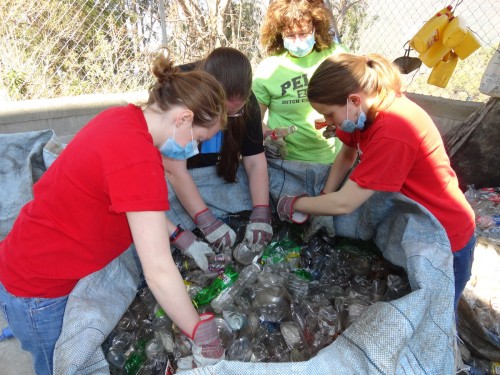Every March, the weather starts to warm up, a few flowers begin to bloom and students eagerly await spring break—a trip to the beach or a week at home with family and friends. But some hop a flight to Guatemala for an international service trip.
Since the spring of 2011, a group of Central students has spent spring break in San Jorge la Laguna, a small village on Lake Atitlán, facilitating environmental and sustainability projects. The first two groups worked to add space at the local school, where 500-600 children attend. The school receives no funding from the government.

“People bring their garbage to the garbage facility, and the workers separate it. All the organic materials go down a chute, and everything else they sort through to see what they can recycle,” Krogstad says.
Biodegradable items are placed in several composting bins, all in different stages of the composting cycle. The group worked with the material ready to be packaged and sent to people in need of composted dirt. The students, all women, packed 110-pound bags full of dirt—and they made their labor a little more musical in the process.
“The ladies started singing while they were working, and it was quite entertaining for the men who were working there with us!” Krogstad says with a laugh.

Hy-Vee donated 50 recyclable bags that the group filled with beans, rice and oil—staples in the Guatemalan diet—to give away as prizes. Emma Putnam, senior art major, recalls not understanding some of the presentation (the native language is Kaqchikel, a form of Mayan, and Spanish is secondary), but she could tell the women were interested and excited to learn.
“Afterwards, the women said they were very happy that we shared with them and they learned a lot from it,” Putnam says. “They didn’t understand everything that was going into the garbage plant, so a bunch of the women came with us and checked it out. They saw what we were doing with the compost—they had never seen it because their children are sent to dispose of the household garbage every week.”
“We were able to learn how to make tortillas and help in the kitchen,” Putnam says. “I was also allowed to try on some traditional Mayan clothing. It was really great to stay in their homes and see what their life is like. The experience was, sometimes, overwhelming but it felt amazing to be there.”
With much work still to be done in the small village, Krogstad hopes to return next year with another contingent of students to work on whatever the town needs. But until then, she imagines that this year’s group took away much more than dirty hands.
“Doing these projects is a way of showing respect for the people, their culture and their way of life,” says Krogstad. “Hopefully that makes an impact on them as well as us. Through this shared experience, they learn a little about us and we learn a little about them, and that makes everybody’s perspective on the world a little more open.”

